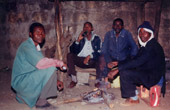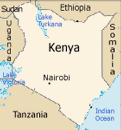
Security men guarding a home in Mathare Slum ©Mohammed Nur
Article Information
Galleries
Article Information
Kenya home page
Mathare Slums
Mohammed Nur
Mungiki
Mysa
Back to top
Mathare Slum
Encyclopedia.comArticle on the curfew in Mathare
The Internet Foundation
Links to organisation with an interest in Kenyan slums
Kenya Water Health Organisation
Article about the water supply in Nairobi's largest slum, Kibera
Missionairies of Africa
Mathare School building Project
MYSA-Mathare slum
Frequently asked questions about the Mathare slums and the MYSA project
Back to Article Information
Back to top
Mohammed Nur
Dan EldonSupporting "Creative Activists"
Digital School
Educational Project
Game of Life
A film made as part of the MYSA project in Nairobi Kenya, highlighting AIDS awareness
Global Eye
Nairobi in camera
Painter
Article about the painter Rene Klarenbeek
Back to Article Information
Back to top
Mungiki
BBC-Mungiki SectArticle from the BBC about the Mungiki Sect
Rick Ross Institute
Links to lots of articles on the Mungiki Sect
Wikipedia-Mungiki
Wikipedia Article
Back to Article Information
Back to top
MYSA
MYSA home pageMathare Youth Sports Association home page
MYSA
MYSA Shootback Project
Back to Article Information
Back to top
Galleries
Mathare Slums
Back to top
Raised in Nairobi, Kenya, Mohammed Nur’s photographs depict the everyday lives and conditions of the citizens of Mathare slums, the second largest slum in Kenya and home to half a million adults and children.
The Mathare slums are situated a few kilometres northwest of the affluent areas of Nairobi, Kenya’s capital. Its inhabitants, mainly women and children, live in small shacks about three square metres, made out of any material they can find; mud, sticks, cardboard and tin sheeting. The homes have no water, electricity, toilets or sanitation. Even though they have very few belongings, their homes are under constant threat from gangs. Many people employ security guards to protect themselves. At the time of writing (12/06/07) the residents of the Mathare slums have had a curfew placed on them because of the actions of Mungiki adherents. The Mungiki started as a religious sect in 1998 but are now more of an organised underworld gang operating in the capital and parts of the Central Rift Valley Provinces. In Mathare the gangs operate illegal electricity and water connections, charge the residents to use the communal toilets and fees for personal protection. Lately they have been involved in crimes of abduction, torture and beheading.
Other problems facing the Mathare residents are illness, lack of water and sanitation. Water, some 10-20 litres a day, has to be bought, often at prices higher than middle or high income families who receive theirs through the tap. When there is a reliable supply of water it cost between 2-4 KSH per 20 litre jerry can, often there is not and then it can cost between 5-20 KSH. To put this in to perspective it means that at its highest the residents of Mathare are paying the same price as London water. Much of the illness, apart from AIDS, can be attributed to either water shortages or too much water. When it rains, the water flows down the hill, through the garbage and human waste and in to broken water pipes. Sanitation is also a major problem. Most people use pit latrines which are inadequate and fill up quickly. There is also very little provision for emptying them. At night residents will often use plastic bags and throw them on the roof, these are commonly known as "Flying toilets", rather than risk going out to the few communal latrines.
In spite of all the hardship a community spirit thrives. The women know that they are solely responsible for earning money to pay for the rent and food for their family and can't afford to be ill. That's why they have started up self-help groups with between 10 and 20 members who cover for each other, helping to look after the children whilst they recover.
One such organisation, MYSA - Mathare Youth Sports Association, has helped over 15,000 Kenyan youths. Started in 1987 as a small self help youth project to organise sport, it has grown to be the largest sports and community service organisation in Africa. Its activities include:
- Youth Development
- Linking sport and environmental cleanup
- Reducing diseases and death in slums
- Tackling the AIDS threat
- Reducing substance abuse
- Helping young leaders stay in school
- Helping Mathare youth excel in school
- Encouraging young artistic talents
- Helping jailed kids
- Changing gender attitudes
- Practicing good governance and accountability
- Expanding horizons and hopes
- Creating new role models
- Changing public images of slums
- Changing distorted images of Africa
Another scheme run by Mysa, the "Shootback project", inspired in 1999 a seventeen year old Mohammed Nur to take the pictures shown above. At the time his first thoughts were "What’s good about taking pictures?" But as time passed and with the help of the Shootback project who gave him the skills, technical know how and a place through regular meetings to discuss local community issues "Things started sounding interesting". His aim in the future is to be a photographer or journalist.
For further information we’ve put all the links to the organisation mentioned in the sidebar under article information.







